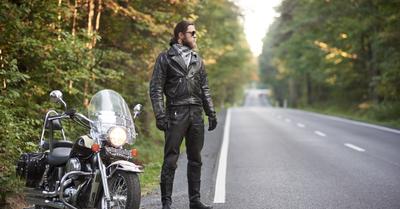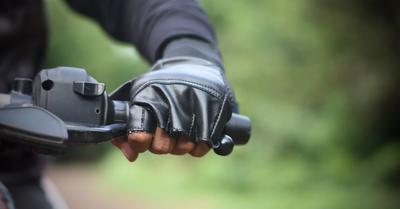How Many States Have Helmet Laws?
Most states have some form of restrictions on helmet use for minors and on the helmet's safety rating. Presently, only three states have no helmet laws (Iowa, New Hampshire, and Illinois). Nineteen states and the District of Columbia have mandatory laws in place requiring all riders to wear helmets. Before purchasing a helmet, it is always a good idea to know the specific regulations that your state of residence requires to ensure that your helmet meets any safety code that might be required.
How Much Does A Motorcycle Helmet Cost?
Finding a good, quality helmet does not have to break the piggy bank. There are many choices available in motorcycle helmets that can cost as little as $35-$75 to helmets that run in the thousands of dollars. A reasonable estimate one can expect to spend about $150 for a DOT (Department of Transportation) approved helmet. Be sure to look for the sticker that indicates that the helmet has met safety standards so that it will resist the impact of a crash.
What is a Motorcycle Helmet Made of?
Believe it or not, there is a lot that goes into the development and construction of a motorcycle helmet. Generally, the helmet is composed of a polystyrene inner layer that cushions the head in the case of an impact and an outer layer made of Kevlar, Polycarbonate plastic, or fiberglass. Cloth straps are sometimes added to help secure the helmet in place. While there are many different styles of helmets, and every helmet must meet safety standards, carbon fiber helmets are generally considered to be the safest helmets to wear, and they are also the most expensive to purchase.
What are Some Considerations for Purchasing a Helmet?
No cyclist should purchase a helmet without some careful consideration. Choosing any old helmet will likely create further issues down the road. What should a buyer look for in a motorcycle helmet?
Decide on a Price, but Don’t Buy Cheap
Everyone has a budget, but buying the cheapest helmet one can find is never a good idea. Most cheap helmets are priced that way for a reason. Even though the DOT has strict standards for manufacturing motorcycle helmets, saving a few dollars may mean that the helmet barely passed the safety standards or, worse, one that won’t hold up in a severe accident.
Obviously, if money is no object, then spend away and get a top-of-the-line helmet to use.
Choose a Style
There are as many different configurations of motorcycle helmets as there are motorbikes. A good idea is to go to a motorcycle dealer and learn about the available styles. Most dealerships have sales consultants who are happy to aid you in choosing the best style that fits your needs and looks good, too. Be aware that full-face helmets protecting the entire head, neck, and chin area are the safest helmets. Here are some of the available choices.
- Full-face - covers the entire head, neck, and chin area. One of the safest helmets to buy.
- ¾ Helmet - covers the head but not the face. Leaves the chin area exposed.
- Half Helmet - covers the top of the head to the back. Sits above the ears.
- Off-Road - specifically designed for motocross or racing.
- Modular - Helmet that has a visor in front that flips up.
- Dual Sport Helmet - covers the entire head and face for use on the street or racing.
The Fit and Feel
Ultimately, the fit is what matters concerning a helmet. If you wear a helmet that is too large, an accident can slam the helmet into the skull with excessive force and cause multiple injuries. Similarly, if a helmet is too small, some area of the head, face, or chin is likely to be exposed to the pavement. (This is not a good thing).
The best way to ensure a good fit for a helmet is to go to the dealer and spend some time trying on the merchandise. A helmet should fit comfortably but not move back and forth on the head once strapped. Assess the helmet's weight (remember you will wear it, sometimes for lengthy periods). A helmet should fit snugly but not so tightly that it creates pressure points on the forehead, scalp, or temples. Here is a helpful chart that might make it easier to determine your best size.
Safety Standards
There are a couple of organizations that certify the safety of motorcycle helmets. The DOT (Department of Transportation) has standards for penetration, the field of vision, and a whole host of other tests. DOT-approved helmets must carry an approved sticker, so look for that label when considering a purchase.
The Snell Memorial Foundation is another agency dedicated to protecting riders and racers by promoting the safe usage of helmets. Named for Pete Snell, a race car driver who died in the late 1950s from head injuries when his helmet failed. This non-profit group conducts a battery of tests that would satisfy your grandmother and then some. A Snell-certified helmet uses some of the latest technology to measure the impact of helmets before, during, and after a crash. They run many more tests than the DOT and set very high standards. Rest assured, a Snell helmet is the safest helmet on the market. Snell-certified helmets should also have a corresponding sticker and barcode.
What About a Helmet for Passengers?
Many motorcycle enthusiasts forget to consider the fact that passengers who ride need to be protected as well. Many states require any passenger to wear a protective helmet regardless of age. While it might not be the best financial situation to have to shell out money for two helmets, it will undoubtedly be worth it if you plan on anyone climbing on the bike with you.














